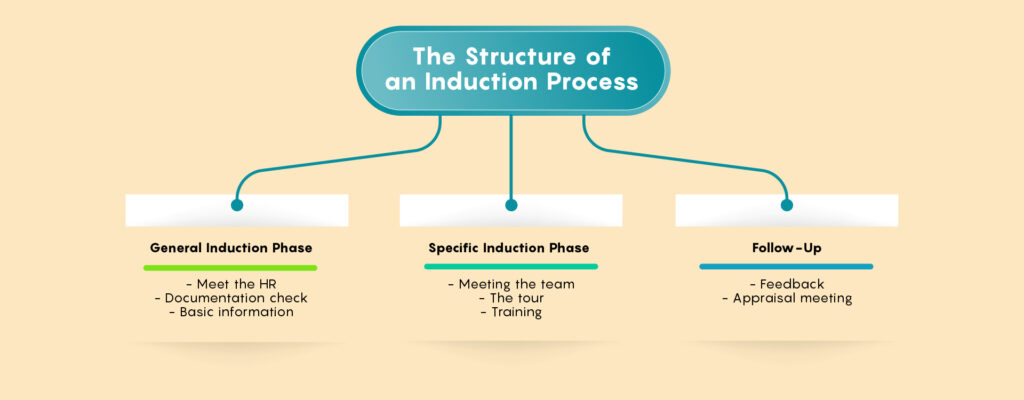No one likes being the new kid at school, but everyone has gone through it at one point or another. Having to face that adjustment period can be quite a daunting task. Regardless of how good the school may be, it takes a while to find your footing and get into the rhythm of the classes, making new friends, understanding the temperament of the teachers and so on.
When a new employee joins a company that is pretty much what they have to deal with as well. Getting integrated into a new work environment takes time, patience and effort. Let us have a look at how this can be done best.

What Is The Induction Process All About?
Induction is a process of integrating employees into – and familiarising them with the organisation once they join. It is the introduction to their new job. This includes several different steps which can range from meeting the staff, getting familiar with the job and learning the new policies. The end goal is to get them comfortable and ready to work as soon as possible.
The only hiccup here is that the induction process often gets confused with the onboarding process. Yes, both have to do with getting the employee familiar with the company but they could not be more different. The induction process focuses on the introduction of the employees to their specific job role and their immediate work environment. Additionally, this also includes some background of the company’s mission, vision and overarching structure.
On-boarding, on the other hand, focuses more on the organisation as a whole and can last up to a year in duration, because realistically it will take a while to get to know the whole of the company. Think of it like this:
If induction is the student being familiarised with the new class schedule and faculty of one department, then onboarding is the process of them getting to know the college as a whole and familiarise with every other aspect like the security, janitorial staff, cafeteria timings, college culture and so on.
‘‘
If onboarding is the process of integrating the employee into the company, induction is the process of integrating them into their new job.
The Importance Of Induction
The induction process not only shows employees the ropes of their new responsibilities, but it also introduces a sense of belonging, which is crucial in the long run. It is mutually beneficial to both the employees as well as the company: the process creates a sense of unity and shows them that working at the company is a pleasant experience. On the other hand, it benefits the company because an employee who likes the work culture is more likely to stay on for a longer period.
Beyond retaining the employees, it is also a good opportunity to strengthen your brand image and make a good first impression. Ask yourself – “What image do I want my business to convey the minute people walk into the workplace?”
From a purely economic standpoint, a well-structured induction process will boost morale and increase productivity and efficiency in the workplace. This will save the business time and money down the road.
Structuring A Well-Planned Strategy
Generally, any decently thought-out induction strategy will consist of three broad stages with multiple parts to them which gives employees a well-rounded introduction to the work environment. The three stages are the general, specific and follow-up induction phases. Here is the breakdown.

General Induction Phase
This is the first phase of the induction process and has to do with familiarising the employee with the overall environment, the mission, the vision and taking care of their documentation. The exact steps are as follows:
Meet the HR
The employee will first meet the HR department as it is usually responsible for conducting the induction. HR’s primary responsibility is to handle the people in an organisation and is connected at all levels, so any issues that arise can quickly be squashed.
Documentation check
At this point employees will have to sign the employment contracts that they should have received by now. Usually, this happens within two months before the official start date. Whatever other documents need to be processed like bank details, personal contact information, administrative registration, access cards, contracts and so on will be handled here.
Basic information
After all that is done, the employee will start getting familiar with the general background of the company such as company policies, rules and regulations, the mission and vision of the company, workplace etiquette that is expected and so on. A good way to do this on a large scale is to keep an online version of an employee handbook ready for quick and wide-spread sharing.
Specific induction phase
The specific induction is handled by the employee’s supervisor. This focuses on the overarching role of the employee’s new job. It is more specific and narrower.
Meeting the team
First you introduce the newcomers to their colleagues as well as the managers of other departments that they might be working closely with. It is important to make an introduction so they feel at ease and get a feel for the energy of the people they will be working every day with.
Time for a tour
Pretty much what it sounds like. You show the employees around the building, get them familiar with their new workspace. For example, if you have a fingerprint scanner or a time-card marker, show them how to use it, even if it is just how to operate the coffee machine in the break-room. Make them feel at home.
Time for training
Before asking employees to get to work always cover your bases. Give them the necessary safety and technical training they will need to operate efficiently on a day-to-day basis without any risk of harm. Remember, you as the business owner are liable for any injuries or lack of necessary skills that they should have been given.
This is especially true if it is in a dangerous work environment where they might be operating heavy machinery, industrial fryers like in fast-food restaurants or construction. This step will also help highlight which areas an employee may be lacking in and you can accordingly schedule in a training session to bridge that knowledge gap.
Follow-Up
This is the final stage of the induction process and is just to see if the employee is settling in well or not. It is usually carried out by their immediate supervisor or a qualified specialist who is hired by the company to assess the situation objectively.
Feedback
The feedback of the employee should be duly noted on how well the induction process went, what could have been better and so on. This will help improve your induction strategy for future employees.
Appraisal meeting
It is also equally important to give the employee feedback on how they can improve their efforts of getting integrated into the company dynamic. Keep them on the right track. Think of this as a mutual performance review and it has to be a dialogue. It is not a one-way street.
Different Types Of Inductions
There are a few different kinds of induction strategies, and you need to choose the one that best suits your organisation. Let us have a look at which one works for you:
Formal
This method is very rigid and well-structured. It is usually carried out by a large-scale organisation and is a very intricately designed program. It covers everything from the mission, vision and rules to the salary, benefits and holidays.
Informal
An informal induction is exactly that, it does not last very long and is usually handled on a much smaller scale than the formal one. It is very casual and completely depends on the managerial style of the company.
Individual
It is a very time-consuming process that is not ideal for a large-scale business. Usually adopted by the smaller-firms that have a smaller employee base, it focuses on the individual needs of the employee and works to get them oriented.
Collective
It is a group orientation and lumps in people under a homogenous method. It lacks the personal touch of the individual style but makes up for inefficiency. Since it is focused on groups it saves time and money and can be used by large organisations.
Serial or Disjunctive
Serial induction basically refers to a mentorship where a senior employee guides the newcomers through the process to preserve the style of work and the work culture. The disjunctive style on the other hand gives the employees no guide or mentor and pushes them to get creative and adapt fast by thinking on their feet.
Investiture and Divestiture
Investiture induction essentially seeks to ‘invest’ in the skills and talents of an employee and focuses on cultivating them. Usually, this is for high-level positions for people with decades of experience or who display extreme talent in a particular field. On the opposite end of the spectrum is divestiture which seeks to change certain characteristics and skills of a person to better suit the job role. This is regardless of the fact that they were selected based on existing skills or traits.
‘‘
You do not have to follow any one of these above methods to the letter. Rather, form your own signature induction process based on the requirements of your business.
A Few Tips To Improve The Process
Get creative and stay positive
The first impression is the best impression definitely applies here. Use a lot of positive and constructive language when walking employees through the induction process. While you are doing that make sure to highlight the best aspects of the company and if you are doing something like a presentation to get things started, use a lot of visuals parallelly to really engage with them.
Encourage social interactions
Plan some fun activities like maybe a fun company dinner so everyone can talk and get to know each other. Socialising outside of work hours is the best way to get someone acquainted and comfortable with the team quickly.
Give them something to remember
It is always appreciated if you take the time and effort to put together a welcome-gift-basket for them. Show them you care and that you want them to feel as though it is their company as much as yours.
Whatever the process you choose to undertake, at the end of the day, it is your call as the business owner what should be. Keep in mind that it is an expensive and time-consuming process, but crucial for a well-structured team building nonetheless. Check out our article on team building to learn more about that!




